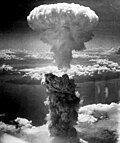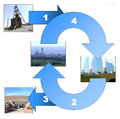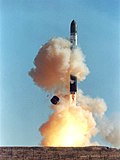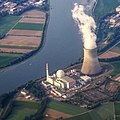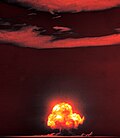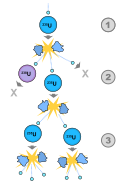
Back بوابة:تقانة نووية Arabic Portal:Kernenergie German درگاه:فناوری هستهای Persian Portail:Nucléaire French Portale:Energia nucleare Italian Portal:原子力 Japanese Portal:Teknologi nuklear Malay ද්වාරය:න්යෂ්ටික තාක්ෂණය Singhalese Portal:核技术 Chinese
The Nuclear Technology Portal
Introduction

- Nuclear technology is technology that involves the nuclear reactions of atomic nuclei. Among the notable nuclear technologies are nuclear reactors, nuclear medicine and nuclear weapons. It is also used, among other things, in smoke detectors and gun sights. (Full article...)
- Nuclear power is the use of nuclear reactions to produce electricity. Nuclear power can be obtained from nuclear fission, nuclear decay and nuclear fusion reactions. Presently, the vast majority of electricity from nuclear power is produced by nuclear fission of uranium and plutonium in nuclear power plants. Nuclear decay processes are used in niche applications such as radioisotope thermoelectric generators in some space probes such as Voyager 2. Reactors producing controlled fusion power have been operated since 1958 but have yet to generate net power and are not expected to be commercially available in the near future. (Full article...)
- A nuclear weapon is an explosive device that derives its destructive force from nuclear reactions, either fission (fission or atomic bomb) or a combination of fission and fusion reactions (thermonuclear weapon), producing a nuclear explosion. Both bomb types release large quantities of energy from relatively small amounts of matter. (Full article...)
General images -
Selected article -
Project Alberta was formed in March 1945, and consisted of 51 United States Army, Navy, and civilian personnel, including one British scientist. Its mission was three-fold. It first had to design a bomb shape for delivery by air, then procure and assemble it. It supported the ballistic testing work at Wendover Army Air Field, Utah, conducted by the 216th Army Air Forces Base Unit (Project W-47), and the modification of B-29s to carry the bombs (Project Silverplate). After completion of its development and training missions, Project Alberta was attached to the 509th Composite Group at North Field, Tinian, where it prepared facilities, assembled and loaded the weapons, and participated in their use. (Full article...)
Selected picture -

Did you know?
- ... that the British Tychon missile was developed from a Barnes Wallis concept to keep strike aircraft safe while dropping nuclear bombs?
- ... that the 1991 Andover tornado narrowly avoided hitting two warplanes equipped with nuclear warheads?
- ... that music manager Alan Wills learned about management from his father, who was "in charge of the UK's nuclear early warning system"?
- ... that the Manhattan Project feed materials program used uranium ore from a mine in Canada near the Arctic Circle?
- ... that the Russian and Belarussian military exercise Zapad 2009 involved nuclear-capable ballistic missiles?
- ... that the area of Cultybraggan Camp has been a royal hunting ground, a prison for fervent Nazis and the site of an underground bunker intended for use in a nuclear war?
Related WikiProjects
Things you can do
| Parts of this portal (those related to section) need to be updated. Please help update this portal to reflect recent events or newly available information. Relevant discussion may be found on the talk page. (September 2021) |
|
Here are some Open Tasks :
|
Selected biography -
Born in Austria-Hungary in 1908, Teller emigrated to the United States in the 1930s, one of the many so-called "Martians", a group of prominent Hungarian scientist émigrés. He made numerous contributions to nuclear and molecular physics, spectroscopy (in particular the Jahn–Teller and Renner–Teller effects), and surface physics. His extension of Enrico Fermi's theory of beta decay, in the form of Gamow–Teller transitions, provided an important stepping stone in its application, while the Jahn–Teller effect and the Brunauer–Emmett–Teller (BET) theory have retained their original formulation and are still mainstays in physics and chemistry. According to Freeman Dyson, Teller thought about his problems using basic principles of physics and often discussed with other cohorts to make headway through difficult problems. This was seen when he worked with Stanislaw Ulam to get a workable thermonuclear fusion bomb design (a solution to Teller's own classical thermonuclear bomb proposal) but later temperamentally (and with fury) dismissed Ulam's aid. Herbert York stated that Teller utilized Ulam's general idea of compression and heating to start thermonuclear fusion to generate his own sketch of a "Super" bomb that would work. Prior to Ulam's idea, Teller's classical Super was essentially a system for heating (using a fission bomb primary) uncompressed liquid deuterium to the point, Teller hoped, when it would sustain thermonuclear burning. It was, in essence a simple idea from physical principles, which Teller pursued with a ferocious tenacity even if he was wrong or shown that it wouldn't work. To get support from Washington for his Super weapon project, Teller proposed a thermonuclear radiation implosion experiment as the "George" shot of Operation Greenhouse.
Teller made contributions to Thomas–Fermi theory, the precursor of density functional theory, a standard modern tool in the quantum mechanical treatment of complex molecules. In 1953, with Nicholas Metropolis, Arianna Rosenbluth, Marshall Rosenbluth, and Augusta Teller, Teller co-authored a paper that is a standard starting point for the applications of the Monte Carlo method to statistical mechanics and the Markov chain Monte Carlo literature in Bayesian statistics. Teller was an early member of the Manhattan Project, which developed the first atomic bomb. He made a serious push to develop the first fusion-based weapons, but ultimately fusion bombs only appeared after World War II. He co-founded the Lawrence Livermore National Laboratory and was its director or associate director. After his controversial negative testimony in the Oppenheimer security clearance hearing of his former Los Alamos Laboratory superior, J. Robert Oppenheimer, the scientific community ostracized Teller.
Teller continued to find support from the US government and military research establishment, particularly for his advocacy for nuclear energy development, a strong nuclear arsenal, and a vigorous nuclear testing program. In his later years, he advocated controversial technological solutions to military and civilian problems, including a plan to excavate an artificial harbor in Alaska using a thermonuclear explosive in what was called Project Chariot, and Ronald Reagan's Strategic Defense Initiative. Teller was a recipient of the Enrico Fermi Award and the Albert Einstein Award. He died on September 9, 2003, in Stanford, California, at 95. (Full article...)
Nuclear technology news
- 15 May 2025 – Iran–United States relations
- U.S. president Donald Trump says that the U.S. and Iran have "sort of" agreed on the terms of a deal on Iran's nuclear program, which reportedly includes Iran agreeing to give up highly enriched uranium while keeping lower-grade uranium needed for civilian nuclear power, in exchange for the lifting of sanctions. (AP)
Related portals
Related topics
Subcategories
Associated Wikimedia
The following Wikimedia Foundation sister projects provide more on this subject:
-
Commons
Free media repository -
Wikibooks
Free textbooks and manuals -
Wikidata
Free knowledge base -
Wikinews
Free-content news -
Wikiquote
Collection of quotations -
Wikisource
Free-content library -
Wikiversity
Free learning tools -
Wiktionary
Dictionary and thesaurus
© MMXXIII Rich X Search. We shall prevail. All rights reserved. Rich X Search



























